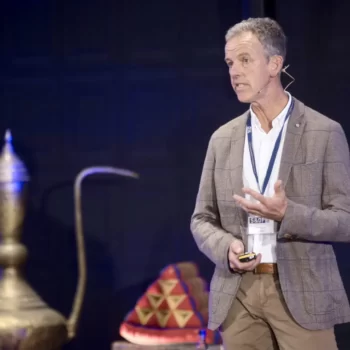Henkel presses the reset button ahead of IBP implementation

After implementing sales & operations planning (S&OP), companies soon face the next challenge: the transformation to integrated business planning (IBP). During the recent S&OP Vendor Day, Henkel and AkzoNobel shared details of their experiences with the attendees. One thing is clear: IBP implementation places greater demands on an organization than S&OP implementation does. “We decided to lower the initial hurdle,” stated Henkel’s Ariane Longpré.
By Marcel te Lindert
When Ariane Longpré (photo, on the screen) became responsible for leading the IBP project in the Henkel detergent division in May of this year, after having worked for many years in Henkel’s adhesives division, she immediately hit the reset button. “I found myself in a cross-functional team that had already made all the preparations. Six pilot countries were in the starting blocks. All the preconditions had been met. And yet we still haven’t got the project underway,” she commented.
After starting in her new role, Longpré first talked to the 50 to 60 people within Henkel who were involved in the project. Everyone understood what IBP meant and why it was a good idea to implement it, but no one had a concrete understanding of what IBP actually meant in practice. “That’s essential before you can start such a complex project – and it certainly was complex, involving six pilot countries and dozens of people across different disciplines. That’s why we put the project on hold for a while.”
Lower initial hurdle
At Henkel, they decided to lower their expectations and to start in just one country rather than six, which allows to test and learn. That would enable them to monitor the pilot project closely and learn every lesson there is to learn. “A pilot in a single country enables us to stay on top of it better, so that we can make the IBP concept tangible for everyone. Another change is that we’re using new technology right from the start, because we’re convinced that the technology is necessary to create value.”
The decision to press the reset button created some communication challenges within the detergent division. “After announcing that we were putting the project on hold so that we could rethink everything, we soon realized that we also had to make it clear that we still planned to implement IBP eventually. This coming January, we will start in the country with the people who are most enthusiastic to take the lead. After all, they are the ones who will have to be IBP ambassadors towards the rest of the company.”
Six hurdles
 Later on during S&OP Vendor Day, Filip Buytaert (photo on the right) shared details of his experiences of implementing IBP at AkzoNobel and two previous employers. He referred to it as a hurdle race in which companies have to overcome six hurdles for IBP success. “The first hurdle concerns gaining the CEO’s support. At AkzoNobel, we had a CEO who regarded IBP as the ideal method for executing new strategies. The challenge lies in retaining that support whenever the CEO changes. That takes a lot of effort and persuasive skills every time.”
Later on during S&OP Vendor Day, Filip Buytaert (photo on the right) shared details of his experiences of implementing IBP at AkzoNobel and two previous employers. He referred to it as a hurdle race in which companies have to overcome six hurdles for IBP success. “The first hurdle concerns gaining the CEO’s support. At AkzoNobel, we had a CEO who regarded IBP as the ideal method for executing new strategies. The challenge lies in retaining that support whenever the CEO changes. That takes a lot of effort and persuasive skills every time.”
The second hurdle concerns the large number of formal procedures that are needed to make IBP a success – not only in terms of all the meetings that are required, but also people’s behaviour during those meetings. Are decisions made during the meetings or afterwards? “Don’t underestimate the importance of all those formalities. Process coaches can help you to complete them. And you can invite people from other regions or divisions to attend a meeting and give you their opinions.”
Short term versus long term
The next hurdle relates to the implementation of sales & operations execution (S&OE): a process similar to sales & operations planning (S&OP), but performed weekly with a focus on operational issues. Buytaert: “This is necessary to prevent IBP or S&OP meetings from addressing short-term issues too. We implemented S&OE within AkzoNobel after the pandemic outbreak so that we could focus on the medium to long term in our IBP process.”
The fourth – and perhaps the most important – hurdle concerns getting Finance involved in the IBP process, which is essential to ensure that it doesn’t remain focused on volumes only but also considers the impact on financial performance. “It’s always difficult to get Finance on board because they have their own plans and figures. They automatically distrust any plans from Supply Chain.”
Risks and opportunities
The fifth hurdle is about managing risks and opportunities, which requires Sales to be on board. What market opportunities do they see, and how can Supply Chain help the company to capitalize on those opportunities? “Scenario management is important,” said Buytaert. “We’re not very good at that yet within AkzoNobel. My advice would be to make sure that the rest of the process is running well first before moving on to scenario management.”
As the sixth and final hurdle, Buytaert referred back to the first hurdle: to ensure that the IBP process remains linked to the strategy and the operation. “Last but not least, I have two pieces of general advice: make sure you have good data – that’s crucial, which is why we’ve invested heavily in data science. And pay close attention to your communication. IBP can be very complex. It’s key to keep your message simple when communicating with Sales, for example.”
No concessions
Longpré concluded her presentation with another important tip: don’t make any concessions. “Present IBP as a cross-functional process that enables growth. IBP is a process for the entire company, not just Supply Chain. It’s about making decisions that are relevant for the overall business. And it’s not only about profitability, but also about growth. That realization caused some surprise within Henkel: was Supply Chain suddenly starting to talk about growth? You can always aim lower, of course, but I’d advise you not to. Stick to your original goal.”
Download the slides of Ariane Longpré and Filip Buytaert!









